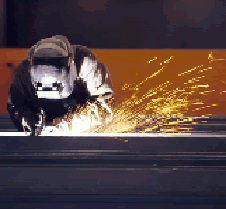Powder Metal Spray Alloys
Aufhauser Powder Metal Spray Alloys are manufactured under exacting conditions, conforming to stringent quality control standards.
The flame spray process is basically the spraying of molten material onto a surface to provide a coating. Material in wire or powder form is melted in a flame (oxy-acetylene flame most common) and atomized using compressed air to form a fine spray. When the spray contacts the prepared surface of a substrate material, the fine molten droplets rapidly solidify forming a coating. This flame spray process carried out correctly is called a "cold process" (relative to the substrate material being coated) as the substrate temperature can be kept low during processing, avoiding damage, metallurgical changes and distortion to the substrate material.
Benefits Of Thermal Spraying
- Comprehensive choice of coating materials: metals, alloys, ceramics, cermets and carbides.
- Thick coatings can be applied at high deposition rates.
- Coatings are mechanically bonded to the substrate - can often spray-coat materials which are metallurgically incompatible with the substrate, e.g., materials with a higher melting point than the substrate.
- Components can be sprayed with little or no pre- or post-heat treatment, and component distortion is minimal.
- Parts can be rebuilt quickly and at low cost, and usually at a fraction of the price of a replacement.
- By using a premium material for the thermal spray coating, coated components can outlive new parts.
- Thermal spray coatings may be applied both manually and automatically.
AUFHAUSER HOT PROCESS
Aufhauser Hot Process Powder Metal Spray Alloys are manufactured under exacting conditions, conforming to stringent quality control standards.
These alloys are functional in all "hot" process flame spraying torches and are totally comparable (frequently superior) to other trade name powders. By "hot", we mean the powder metal alloys are produced to perform in the brazing range of approximately 1850-1950°F (1010-1066°C).
The manufacturing process of these products is unique in that the powder metal alloys are melted in a vacuum or inert atmosphere and spherically atomized from melt ladle to screening (the particles never touch water and are never crushed or pulverized). This assures the powders to be free of oxides, resulting in cleaner application with maximum density.
Designed for convenient reference, the Selector Chart below should enable you to easily and quickly select the AUFHAUSER Hot Process Powder Metal Spray Alloys best suited to your specific applications.
Packaging: All Aufhauser Hot Process Powder Metal Spray Alloys are packed in 1 and 5 lbs. sealed plastic containers.
Selector Chart: AUFHAUSER ("Hot" Process) Powder Metal Spray Alloys
|
||||||||||||||||||||||||||||||||||||||||||||||||||||||||||||||||||||||||||||||||||||
AUFHAUSER COLD PROCESS
Aufhauser Bonding Process is an innovative process whereby metal particles derived from special formulae are fed into an oxyacetylene flame and deposited evenly in thin coats to a metal part turning on a lathe.
To clarify the "cold" process, the powders are heated in the oxyacetylene flame and reach an exothermic stage, becoming autogenic as they strike the base metal part turning on a lathe. (Note: This process is restricted to lathe applications; it will not be successful other than when the part is turning on a lathe.) As the powders become autogenic, the self-generated heat is greater than that produced by the oxyacetylene flame, resulting in a strong bond even though the temperature of application never exceeds 650°F (343°C). This obviously prevents warpage, distortion or metallurgical changes in the part to be built-up.
Aufhauser Bond Powders are functional in all "cold" process flame spraying torches and are totally comparable (frequently superior) to other trade name powders.
Worn parts, rebuilt with the Aufhauser Bonding Process, can last from two to five times longer than the original parts, yielding creditable savings factors.
Designed for convenient reference, the Selector Chart below should enable you to easily and quickly select the Aufhauser Bond Powder Metal Spray Alloys best suited to your specific applications.
(For more detailed information on the Aufhauser Bonding Process please see Aufhauser Bonding Brochure ![]() .)
.)
Packaging: All Aufhauser Bond ("Cold" Process) Powder Metal Spray Alloys are packaged in five pound sealed plastic containers.
The complete Aufhauser Bond Duel Spray Torch Kit contains 1 - Dual Spray Torch; an assortment of Aufhauser Bond powder cartridges; 1 - 200°F and 1 - 650°F Tempil sticks; 1 - can of cleaner; and instructions.
Selector Chart: Aufhauser Bond ("Cold" Process) Powder Metal Spray Alloys
|
||||||||||||||||||||||||||||||||||||||||||||||||||||||||||||||||||||||||||||||||

